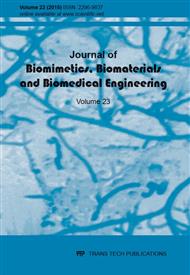[1]
Hamed Elham, et al. 2012. Multiscale Modeling of Elastic Properties of Trabecular Bone, J. Royal Society Interface 9 (72), 1654-1673.
Google Scholar
[2]
Yoon, Y.J., Cowin, S.C.: The estimated elastic constants for a single bone osteonal lamella. Biomech. Model. Mechanobiol. 7, 1–11 (2008).
DOI: 10.1007/s10237-006-0072-8
Google Scholar
[3]
Rho J.Y., Kuhn-Spearing L., Zioupos P. 1998. Mechanical properties and the hierarchical structure of bone. Med. Eng. Phys.; 20, 92–102.
DOI: 10.1016/s1350-4533(98)00007-1
Google Scholar
[4]
Vaughan T. J, McCarthy C. T, McNamara L.M. 2012. A three scale finite element investigation into the effects of tissue mineralization and lamellar organization in human cortical and trabecular bone. Journal of the mechanical behavior of biomedical materials, 50-62.
DOI: 10.1016/j.jmbbm.2012.03.003
Google Scholar
[5]
Khaterchi H., Belhadjsalah H. A three scale identification of orthotropic properties of trabecular bone, CMBBE, 2013, vol 16. NO. SI., 272-274.
DOI: 10.1080/10255842.2013.815844
Google Scholar
[6]
Hamed, E., Lee,Y., Jasiuk,I., 2010. Multiscale modeling of elastic properties of trabecular bone. Acta Mechanica 213(1–2), 131–154.
DOI: 10.1007/s00707-010-0326-5
Google Scholar
[7]
Hamed, E., Lee,Y., Jasiuk,I., 2010. Multiscale modeling of elastic properties of cortical bone. Acta Mechanica 213(1–2), 131–154.
DOI: 10.1007/s00707-010-0326-5
Google Scholar
[8]
Yuan F, Stock SR, Haeffner DR, Almer JD, Dunand DC, Brinson LC (2011). A new model to simulate the elastic properties of mineralized collagen fibril., Biomech Model Mechanobiol 10: 147–160.
DOI: 10.1007/s10237-010-0223-9
Google Scholar
[9]
Hang F, Barber AH (2011). Nano-mechanical properties of individual mineralized collagen fibrils from bone tissue, J. R. Soc. Interface 8: 500–505.
DOI: 10.1098/rsif.2010.0413
Google Scholar
[10]
Almer JD, Stock SR (2007). Micromechanical response of mineral and collagen phases in bone., J Struct Biol 157: 365–370.
DOI: 10.1016/j.jsb.2006.09.001
Google Scholar
[11]
Eppell SJ, Smith BN, Kahn H, Ballarini R (2006). Nano measurements with micro-devices: mechanical properties of hydrated collagen fibrils., Journal Of The Royal Society Interface 3(6): 117-121.
DOI: 10.1098/rsif.2005.0100
Google Scholar
[12]
Buehler MJ (2008). Nanomechanics of collagen fibrils under varying cross-link densities: atomistic and continuum studies., Journal of the Mechanical Behaviour of Biomedical Materials 1(1): 59–67.
DOI: 10.1016/j.jmbbm.2007.04.001
Google Scholar
[13]
Abdelwahed Barkaoui, Abdessalem Chamekh, Tarek Merzouki, Ridha Hambli and Ali Mkaddem (2013).
Google Scholar
[14]
Martínez-Reina J, Domínguez J, García-Aznar JM. Effect of porosity and mineral content on the elastic constants of cortical bone: a multiscale approach. Biomech Model Mechanobiol 2011; 10: 309–322.
DOI: 10.1007/s10237-010-0236-4
Google Scholar
[15]
Yoon YJ, Cowin SC. An estimate of anisotropic poroelastic constants of an osteon. Biomechanics and Modeling in Mechanobiology 2008b; 7: 13–26.
DOI: 10.1007/s10237-006-0071-9
Google Scholar
[16]
Rho JY, Zioupos P, Currey JD, Pharr GM. Microstructural elasticity and regional heterogeneity in aging human bone examined by nano-indentation. Journal of Biomechanics 2002; 35: 161–165.
DOI: 10.1016/s0021-9290(01)00199-3
Google Scholar
[17]
Fan Z, Swadener JG, Rho JY, Roy ME, Pharr GM. Anisotropicproperties of human tibial cortical bone as measured by nanoindentation. Journal of Orthopaedic Research 2002; 20: 806–810.
DOI: 10.1016/s0736-0266(01)00186-3
Google Scholar
[18]
Zysset PK, Guo XE, Hoffler CE, Moore KE, Goldstein SA. Elastic modulus and hardness of cortical and trabecularbone lamellae measured by nanoindentation in the human femur. Journal of Biomechanics 1999; 32: 1005–1012.
DOI: 10.1016/s0021-9290(99)00111-6
Google Scholar
[19]
Hoffler CE, Moore KE, Kozloff K, Zysset PK, Goldstein SA. Age, gender, and bone lamellae elastic moduli. Journal of Orthopaedic Research 2000; 18: 432–437.
DOI: 10.1002/jor.1100180315
Google Scholar
[20]
Weiner S, Wagner HD. The material bone: structure mechanical function relations. Annual Review of Materials Research 1998; 28: 271–298.
DOI: 10.1146/annurev.matsci.28.1.271
Google Scholar


